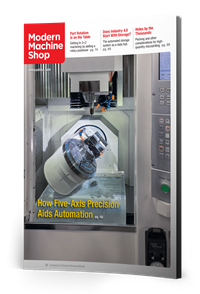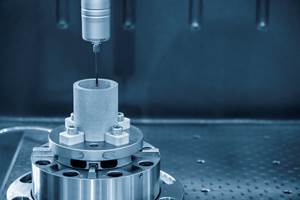Quick Change Workholding For Hard-To-Hold Parts
This pwer chuck features direct transmission of the piston force to the jaws in the area of the jaw guides. The axial actuating force is transmitted to the jaws without major friction loss.
Share





Bryn Van Hiel, owner of Technicast Corporation (South Gate, California), was looking to expand and extend his machine shop's job capabilities. After finding a CNC machine that could handle his machining requirements, a Mori Seiki 2l-3, Mr. Van Hiel found he needed something "extra" when it came to his workholding needs. To meet these "extra" workholding needs, he decided to try the Rohm KFD-HS-type power chuck from Rohm Products of America.
The KFD-HS features direct transmission of the piston force to the jaws in the area of the jaw guides. The axial actuating force is transmitted to the jaws without major friction loss. Other features include low component count; long jaw ways; large bore; universal design of wedge connection (even in the fully retracted position, the wedge neck will not project into the spindle bore area); and short taper mounting. The 15-inch chuck is flexible enough to be used on other machines in his shop, and the special wedge-type design creates reliable, close tolerance repeatability. Additionally, the high speed chuck features a high gripping force. With long, extended adapter plates added to the machine spindle, the chuck allows Mr. Van Hiel to work with 6.5-inch bar stock on all his machines.
Mr. Van Hiel approached Rohm with a request for flexible workholding for both outer diameter (OD) and inner diameter (ID) and clamping with a minimum changeover time. The clamping diameter range he indicated ranged from 3.5 inches to 6 inches ID and 2 inches to 12 inches OD. Jürgen Schleicher, general manager of Rohm Products, said that covering this range would not be a problem for the KFD-HS 15-inch chuck—that is, until Mr. Van Hiel showed him drawings of the workpieces that were to be clamped on the inside diameter.
The workpieces were very thin-walled sleeves, most of them made from exotic brass material and many of them 15 inches to 20 inches long with a ¼-inch wall. Mr. Schleicher found that the only way to accurately hold these sleeves (while machining them to a very tight tolerance) was to design a special mandrel where many different sizes of expanding sleeves and actuating arbors could be changed quickly.
Rohm agreed to come up with a method to "quick change" the 15-inch KFD-HS power chuck with a specially-designed mandrel, including a 12-inch flange and 25-inch length, for clamping the thin-walled sleeves. Both items had to be exchanged on the A2 11-inch Mori Seiki spindle within minutes. Gerard Cochard, Rohm Products vice president of sales and an experienced designer, concurred that Rohm could meet those requirements.
"We can do it this way and hold the accuracy and repeatability of both the chuck and mandrel—exchanged within 0.0001-inch—without any adjustment. That's what the RMS system is designed for," Mr. Schleicher told Mr. Van Hiel.
Because they would be changing components from short taper to short taper, they found that they would not lose any tolerance. According to Mr. Schleicher, with the KFD-HS power chuck's high precision quality, the concept of changing a large range of ground sleeves on the mandrel was realized much easier than Rohm expected.
Rohm provided a basic receiver that was mounted to the A2 11-inch Mori Seiki spindle. This receiver included a bayonet system, which locks the workpiece into position via special cup springs. The power operation was accomplished via a Rohm non-through-hole, hydraulically-operated cylinder that actuates the drawbar with a collet at the end. The collet closes on the retention knob of the chuck or mandrel and opens or closes the chuck jaws or the mandrel sleeves. The collet also releases the workholding retention knob when in the "open" position. The operator has only to turn the mounting bolts (bayonet system) 90 degrees, and the chuck or mandrel can be changed within minutes. The former changeover time of approximately 1 ½ hours was reduced to less than 5 minutes. According to Mr. Schleicher, the accuracy and repeatability has been outstanding for many months now and has convinced even the Technicast CNC operators, who were worried about how long it could last.
Related Content
Briquetting Manufacturer Tools Up for Faster Turnaround Times
To cut out laborious manual processes like hand-grinding, this briquette manufacturer revamped its machining and cutting tool arsenal for faster production.
Read MoreParts and Programs: Setup for Success
Tips for program and work setups that can simplify adjustments and troubleshooting.
Read MoreThe Future of High Feed Milling in Modern Manufacturing
Achieve higher metal removal rates and enhanced predictability with ISCAR’s advanced high-feed milling tools — optimized for today’s competitive global market.
Read MoreShop Reclaims 10,000 Square Feet with Inventory Management System
Intech Athens’ inventory management system, which includes vertical lift modules from Kardex Remstar and tool management software from ZOLLER, has saved the company time, space and money.
Read MoreRead Next
Machine Shop MBA
Making Chips and 91ÊÓƵÍøÕ¾ÎÛ are teaming up for a new podcast series called Machine Shop MBA—designed to help manufacturers measure their success against the industry’s best. Through the lens of the Top Shops benchmarking program, the series explores the KPIs that set high-performing shops apart, from machine utilization and first-pass yield to employee engagement and revenue per employee.
Read MoreAMRs Are Moving Into Manufacturing: 4 Considerations for Implementation
AMRs can provide a flexible, easy-to-use automation platform so long as manufacturers choose a suitable task and prepare their facilities.
Read More





















